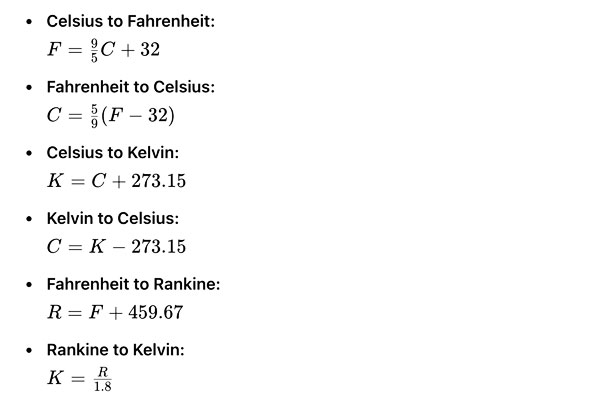Temperaturwandler (℃ ⇄ ℉ ⇄ K)
Temperaturwandler
Bei der Temperaturumrechnung handelt es sich um die Übertragung von Messwerten von einer Temperaturskala in eine andere, wie Celsius zu Fahrenheit oder Kelvin zu Rankine.
Dieser Prozess sorgt für Konsistenz und Klarheit in verschiedenen Regionen und Branchen, die unterschiedliche Temperaturskalen verwenden.
Oberflächenbearbeitung, Wetterberichterstattung, und wissenschaftliche Forschung sind alle auf genaue Temperaturmessungen angewiesen.
Unser Ziel ist es, in die technischen Grundlagen einzutauchen, praktische Anwendungen, und industrielle Bedeutung der Temperaturumwandlung, Veranschaulichung seiner Wirkung anhand von Daten und Beispielen aus der Praxis.
1. Temperaturskalen verstehen
Unterschiedliche Temperaturskalen dienen in der Wissenschaft unterschiedlichen Zwecken, Industrie, und Alltag:
- Celsius (° C): In den meisten Ländern und in der wissenschaftlichen Gemeinschaft weit verbreitet; Wasser gefriert bei 0°C und siedet bei 100°C.
- Fahrenheit (° F): In den Vereinigten Staaten häufig; Wasser gefriert bei 32 °F und kocht bei 212 °F.
- Kelvin (K): Die absolute Temperaturskala, die in der Physik und Technik verwendet wird; 0 K steht für den absoluten Nullpunkt.
- Rankine (°R): Ähnlich wie Kelvin, wird jedoch in thermodynamischen Berechnungen verwendet, vor allem im Ingenieurwesen.
Vergleichstabelle: Wichtige Temperaturskalen
| Skala | Symbol | Gefrierpunkt von Wasser | Siedepunkt von Wasser | Absoluter Nullpunkt |
|---|---|---|---|---|
| Celsius | ° C | 0° C | 100° C | -273.15° C |
| Fahrenheit | ° F | 32° F | 212° F | -459.67° F |
| Kelvin | K | 273.15 K | 373.15 K | 0 K |
| Rankine | °R | 491.67°R | 671.67°R | 0°R |
Diese Skalen bilden die Grundlage für alle Temperaturumrechnungen, Damit können Ingenieure und Wissenschaftler Daten unabhängig von regionalen Standards präzise kommunizieren.
2. So funktioniert die Temperaturumrechnung
Die Temperaturumrechnung basiert auf einfachen mathematischen Formeln, die Messungen zwischen verschiedenen Maßstäben umrechnen. Hier sind einige Schlüsselformeln:

Beispiel für reale Welt
Erwägen Sie eine Umstellung auf 25 °C:

Diese Konvertierungen stellen sicher, dass die Temperaturdaten konsistent bleiben, ob in einem Laborexperiment verwendet, ein industrieller Prozess, oder eine Wettervorhersage.
3. Arten von Temperaturwandlern
Temperaturwandler gibt es in verschiedenen Formen, jedes für unterschiedliche Bedürfnisse geeignet:
Manuelle Konvertierung:
Verwendung mathematischer Formeln, Ideal für Bildungszwecke und schnelle Berechnungen.Online-Tools und Software:
Webbasierte Konverter liefern sofortige Ergebnisse und werden häufig von Profis verwendet, Studenten, und Bastler gleichermaßen. Sie lassen sich häufig in andere digitale Systeme integrieren, Gewährleistung eines reibungslosen Datenflusses.Mobile Anwendungen:
Apps bieten tragbar, Konvertierungsfunktionen für unterwegs, Das macht sie für Reisende und Außendiensttechniker von unschätzbarem Wert.Physische Umrechnungstabellen:
Diese kommen häufig in industriellen Umgebungen vor, Labore, und Produktionsstätten, in denen eine schnelle Referenz erforderlich ist.
4. Industrielle und wissenschaftliche Anwendungen
Ingenieurwesen und Fertigung
- Metallurgie und CNC-Bearbeitung:
Für Wärmebehandlungen und Materialverarbeitung ist eine präzise Temperaturkontrolle von entscheidender Bedeutung. Zum Beispiel, Bereits ein Temperaturfehler von 10 °C kann sich auf die Mikrostruktur von Stahl auswirken, seine Stärke und Haltbarkeit verändern. - Chemische Verarbeitung:
Präzise Temperaturmessungen stellen sicher, dass Reaktionen unter kontrollierten Bedingungen ablaufen, Dies ist für die Produktqualität und -sicherheit von entscheidender Bedeutung.
Medizin und Gesundheitswesen
- Fieberdiagnose:
Medizinisches Fachpersonal ist auf genaue Temperaturumrechnungen angewiesen, um Patientendaten genau zu interpretieren, ob in Celsius oder Fahrenheit gemessen. - Kryogene Anwendungen:
In Bereichen wie Organerhaltung und Kryochirurgie, Umrechnungen in Kelvin sind entscheidend für die Gewährleistung optimaler Temperaturbedingungen.
Lebensmittel- und Getränkeindustrie
- Kochen und Backen:
Rezepte und Industrieöfen erfordern häufig Temperaturanpassungen zwischen Fahrenheit und Celsius, Sicherstellung einer gleichbleibenden Produktqualität. - Lebensmittelsicherheit:
Regulierungsnormen legen häufig Temperaturbereiche in bestimmten Einheiten fest, Dies macht die Konvertierung für die Compliance unerlässlich.
Wissenschaftliche Forschung und Weltraumforschung
- Laborexperimente:
Eine genaue Temperaturumrechnung ist für die Wiederholung von Experimenten und die Wahrung der Konsistenz in der Forschung erforderlich. - Wärmekontrolle von Raumfahrzeugen:
In der Luft- und Raumfahrt, Temperaturmessungen in Kelvin und Rankine sind für die Auslegung von Wärmeschutzsystemen von entscheidender Bedeutung.
5. Neue Technologien in der Temperaturumwandlung
Jüngste Fortschritte verbessern die Genauigkeit und Effizienz von Temperaturumrechnungstools:
KI-gestützte Vorhersage:
Algorithmen für maschinelles Lernen sagen jetzt Temperaturtrends voraus und passen Umrechnungsfaktoren in Echtzeit an, besonders nützlich bei der Klimamodellierung und industriellen Prozessen.IoT -Integration:
Intelligente Sensoren, die mit cloudbasierten Plattformen verbunden sind, liefern Temperaturdaten in Echtzeit und automatisierte Umrechnungen, Dies führt zu reaktionsschnelleren Fertigungs- und Überwachungssystemen.Quantentemperaturmessung:
Spitzenforschung in der Quantenmetrologie verschiebt die Grenzen der Temperaturmessung, entscheidend für Experimente nahe dem absoluten Nullpunkt.
6. Abschluss
Die Temperaturumwandlung ist ein Eckpfeiler der Wissenschaft, industriell, und alltägliche Anwendungen.
Ob Celsius in Fahrenheit für einen Wetterbericht oder Kelvin in Rankine für das thermische Kontrollsystem eines Raumfahrzeugs umgerechnet wird, Eine genaue Temperaturumrechnung stellt sicher, dass die Daten konsistent und zuverlässig bleiben.
Durch das Verständnis der Grundlagen von Temperaturskalen, die mathematischen Prinzipien hinter der Konvertierung, und die verschiedenen verfügbaren Werkzeuge, Profis können Präzision bei ihrer Arbeit gewährleisten.
Da neue Technologien wie KI und IoT die Methoden zur Temperaturumrechnung weiter verfeinern, Wir können in Zukunft noch mehr Effizienz und Genauigkeit erwarten.
Im Wesentlichen, Temperaturumrechnung ist nicht nur eine mathematische Übung; Es handelt sich um einen entscheidenden Prozess, der vielen Facetten moderner Technologie und Industrie zugrunde liegt.
Die Nutzung dieser Fortschritte wird dazu beitragen, Innovationen voranzutreiben und hohe Qualitätsstandards in verschiedenen Bereichen aufrechtzuerhalten.